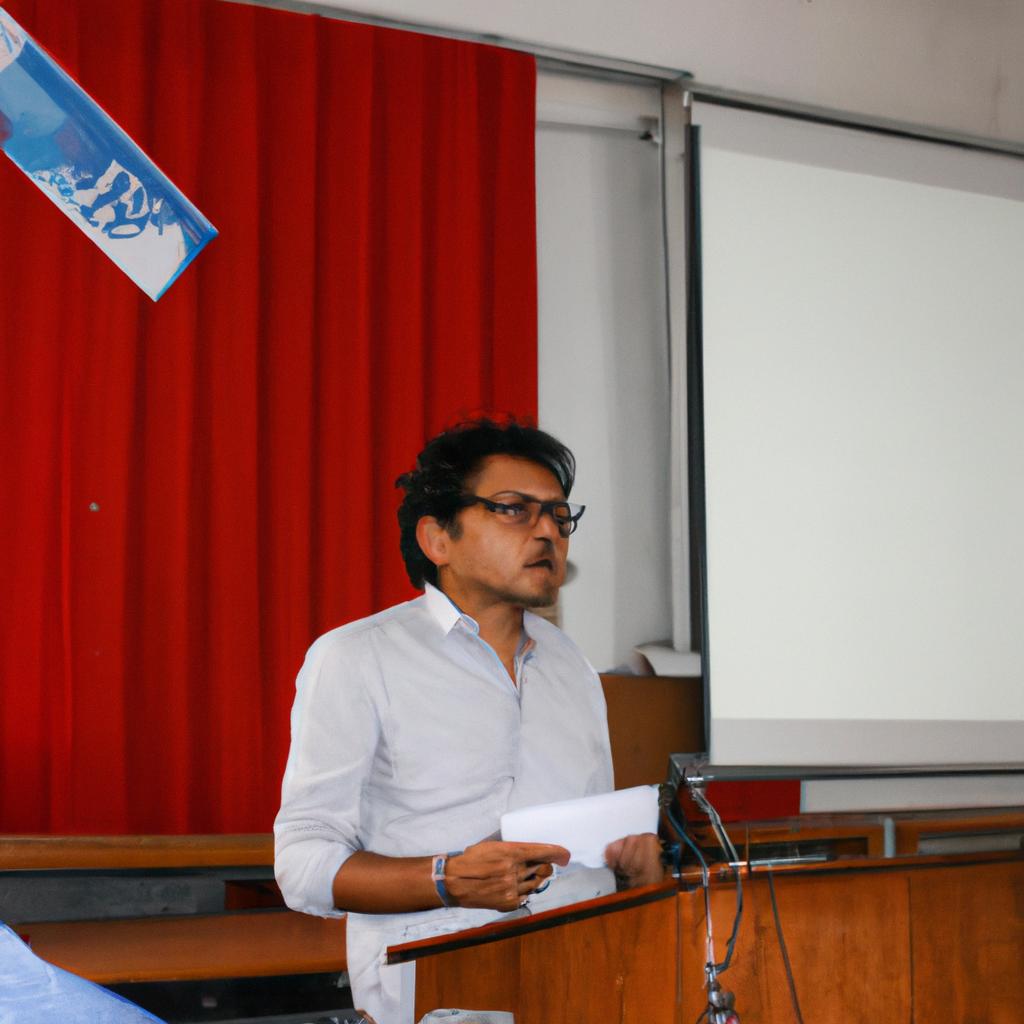Campaign strategies play a crucial role in the success of social sciences organizations, particularly within the realm of political science. These strategies are employed to effectively communicate an organization’s goals and objectives to various stakeholders, mobilize support, and ultimately achieve desired outcomes. Drawing on insights from the field of political science, this article aims to explore different campaign strategies used by social sciences organizations, highlighting their effectiveness and impact.
For instance, consider a hypothetical case study where a non-profit organization focused on promoting environmental conservation is aiming to raise awareness about climate change among policymakers. In order to accomplish this objective, the organization designs a comprehensive campaign strategy that includes targeted messaging, grassroots mobilization efforts, and strategic partnerships with influential policymakers and advocacy groups. By employing these tactics derived from political science research, the organization is able to successfully engage key decision-makers, shape policy discussions surrounding climate change, and mobilize public support for stronger environmental regulations.
By examining such examples through a political science lens, we can gain valuable insights into effective campaign strategies utilized by social sciences organizations. This article will delve deeper into various aspects of campaign planning and execution including message framing, coalition-building techniques, media engagement strategies, voter outreach methods, and data-driven targeting approaches. Through an academic exploration of these topics informed by real campaign examples, we can better understand the underlying principles and best practices that contribute to successful campaign strategies in social sciences organizations.
One important aspect of campaign planning is message framing. Political science research has shown that how an issue is framed can significantly impact public opinion and policy outcomes. Social sciences organizations should carefully craft their messages to resonate with their target audience, using language and narratives that appeal to their values and concerns. For example, an organization advocating for affordable housing may frame their message around the idea of economic stability and community development, rather than solely focusing on the need for housing assistance.
Coalition-building techniques are another key element of effective campaign strategies. By forming alliances with like-minded organizations and individuals, social sciences organizations can amplify their voices and increase their influence. This could involve working with advocacy groups, academics, community leaders, or even partnering with other non-profit organizations. Collaborative efforts strengthen the legitimacy of a campaign and broaden its reach by tapping into diverse networks of supporters.
Media engagement strategies also play a crucial role in shaping public opinion and garnering support for social sciences campaigns. Organizations must effectively leverage various media platforms such as traditional media outlets, social media platforms, blogs, podcasts, and online forums to disseminate information about their cause. Engaging in strategic media outreach activities such as press releases, interviews, op-eds or utilizing digital marketing techniques can help ensure that a campaign’s message reaches a wide audience.
Voter outreach methods are particularly relevant in political science-oriented campaigns aimed at influencing elections or policy decisions. Social sciences organizations often engage in voter registration drives, canvassing efforts to educate voters about specific issues or candidates’ positions through door-to-door conversations or phone banking. Additionally, they may organize town hall meetings or host candidate forums to provide opportunities for constituents to engage directly with policymakers.
Lastly, data-driven targeting approaches have become increasingly prevalent in modern campaign strategies. With advancements in technology and data analytics tools, social sciences organizations can identify specific demographics or geographic areas where their message is likely to resonate the most. By tailoring their outreach efforts and campaign materials accordingly, organizations can maximize their impact and resources.
In conclusion, effective campaign strategies are vital for social sciences organizations seeking to achieve their goals and objectives. Drawing on insights from political science research, these strategies encompass various elements such as message framing, coalition-building techniques, media engagement strategies, voter outreach methods, and data-driven targeting approaches. By understanding and implementing these best practices, social sciences organizations can enhance their effectiveness in communicating with stakeholders, mobilizing support, and ultimately bringing about desired outcomes in the realm of public policy and beyond.
Defining campaign strategies in social sciences organizations
A prime example of the importance of effective campaign strategies within social sciences organizations can be observed in the successful presidential campaign of Barack Obama in 2008. Through meticulous planning and execution, the Obama team employed a range of tactics to connect with voters, mobilize supporters, and ultimately secure victory. This case study serves as an illustration of how strategic campaigning plays a pivotal role in achieving organizational objectives.
Campaign strategies in social sciences organizations are multifaceted and require careful consideration. Firstly, it is essential to identify target audiences and their specific needs and concerns. By understanding these dynamics, organizations can tailor their messaging and methods accordingly, ensuring relevance and resonance with potential supporters or stakeholders.
Furthermore, campaign strategies should aim to foster engagement among target audiences through various means such as community outreach programs, events, and online platforms. The use of technology has become increasingly significant in recent years, allowing for innovative tools like social media campaigns or interactive websites that facilitate dialogue between organizations and their constituencies.
To emphasize the emotional impact of effective campaign strategies within social sciences organizations:
- Empathy: Demonstrating empathy towards constituents’ experiences fosters a sense of connection.
- Inspiration: Inspiring individuals by highlighting shared values motivates them to actively participate.
- Inclusivity: Ensuring inclusivity through diverse representation promotes trust and broadens support.
- Action-oriented: Encouraging tangible actions enables individuals to contribute meaningfully.
The following table further illustrates key considerations when designing campaign strategies:
| Consideration | Role |
|---|---|
| Research | Identifying target demographics |
| Messaging | Crafting compelling narratives |
| Mobilization | Activating grassroots networks |
| Evaluation | Assessing strategy effectiveness |
In conclusion, defining effective campaign strategies is crucial for social sciences organizations seeking to achieve their goals. By tailoring messages to target audiences, fostering engagement through various platforms, and incorporating emotional elements into their strategies, these organizations can maximize their impact. The subsequent section will explore the role of data analysis in informing campaign strategies, further enhancing their effectiveness and relevance.
The role of data analysis in campaign strategies
Defining campaign strategies in social sciences organizations provides a foundation for understanding the key elements that contribute to successful campaigns. Building upon this definition, it is imperative to explore the role of data analysis in shaping these strategies. By leveraging data-driven insights, organizations can enhance their decision-making processes and optimize their efforts towards achieving desired outcomes.
To illustrate the significance of data analysis in campaign strategies, consider the following hypothetical scenario: an environmental advocacy group aiming to raise awareness about climate change and promote sustainable practices. Through careful analysis of demographic information and public opinion polls, they identify specific regions where there is a lack of awareness and engagement with environmental issues. Armed with this knowledge, the organization tailors its messaging and outreach efforts to resonate with the target audience effectively.
The integration of data analysis into campaign strategies can yield various advantages:
- Enhanced targeting: Data allows organizations to pinpoint specific demographics or geographic areas that are most receptive to their message. This enables them to allocate resources efficiently and maximize impact.
- Improved message effectiveness: Analyzing past campaign performance and feedback from stakeholders helps refine messaging strategies. By identifying what resonates with audiences, organizations can craft messages that elicit emotional responses or inspire action.
- Real-time monitoring: Continuous data collection facilitates ongoing evaluation of campaign progress. Organizations can track metrics such as reach, engagement levels, and sentiment analysis to gauge success and make necessary adjustments.
- Evidence-based decision making: Data analysis provides objective evidence on which strategies are working effectively and which require modification. This ensures that decisions are grounded in empirical evidence rather than subjective assumptions.
Table: Examples of Key Performance Indicators (KPIs) for Campaign Strategies
| KPI | Definition |
|---|---|
| Reach | The number of unique individuals exposed to a campaign’s message |
| Engagement | The level of interaction between individuals and a campaign |
| Conversion rate | The percentage of engaged individuals who take a desired action |
| Return on investment (ROI) | The measure of campaign effectiveness in relation to resources invested |
In conclusion, data analysis plays an instrumental role in shaping campaign strategies for social sciences organizations. By utilizing data-driven insights, these organizations can enhance their targeting efforts, improve message effectiveness, monitor progress in real-time, and make evidence-based decisions. In the subsequent section, we will explore how social media platforms can be effectively utilized as part of comprehensive campaign strategies.
Utilizing social media platforms for effective campaign strategies
Building upon the role of data analysis in campaign strategies, it is essential to explore how social media platforms can be effectively utilized as powerful tools within political science organizations. By harnessing the reach and influence of these platforms, organizations can strategically engage with a wider audience, shape public opinion, and mobilize support for their campaigns.
Social media has revolutionized communication and information dissemination, providing an unprecedented opportunity for organizations to connect directly with voters. For instance, consider a hypothetical case study where a political party aims to increase voter turnout among young adults in a local election. By leveraging social media platforms such as Facebook, Twitter, and Instagram, they can employ various strategies:
- Crafting compelling visual content that resonates with the demographic
- Implementing targeted advertising campaigns based on user interests and demographics
- Utilizing influencers or well-known personalities to amplify their message
- Encouraging user-generated content through hashtags and challenges
These tactics not only attract attention but also foster engagement and participation among young adults who are active users of social media. To better understand the impact of utilizing social media platforms in campaign strategies, let us examine a three-column table showcasing key benefits:
| Benefits | Examples | Impact |
|---|---|---|
| Increased visibility | Trending hashtags related to campaign issues | Higher brand recognition |
| Real-time feedback | Polls and surveys | Improved understanding of voter opinions |
| Direct interaction with constituents | Live Q&A sessions | Enhanced trust and rapport |
By capitalizing on these advantages, political science organizations can create a dynamic online presence that enables them to communicate their message effectively while fostering meaningful connections with potential supporters.
Engaging with stakeholders in campaign planning requires careful consideration of various factors. In our subsequent section about “Engaging with stakeholders in campaign planning,” we will delve into the importance of involving key stakeholders, such as volunteers, community leaders, and donors, in shaping campaign strategies. By actively engaging with these individuals, organizations can create more inclusive and impactful campaigns that resonate with their target audience and ultimately achieve their goals.
Engaging with stakeholders in campaign planning
Building on the effective utilization of social media platforms in campaign strategies, organizations must also focus on engaging with stakeholders during the planning phase. By involving key individuals and groups, social science organizations can ensure that their campaigns are tailored to address specific interests and concerns. This section explores the importance of stakeholder engagement in campaign planning and outlines some key strategies for successful implementation.
Engaging with stakeholders is crucial as it allows organizations to gain valuable insights into the needs and expectations of different interest groups. For instance, consider a hypothetical case where a political science organization is planning a campaign to promote voter registration among young adults. By consulting with representatives from youth advocacy groups, academic institutions, and community leaders, they can gather information about barriers to registration faced by this demographic and design targeted messages accordingly.
To effectively engage with stakeholders in campaign planning, organizations should consider the following strategies:
- Conducting stakeholder mapping: Identify relevant individuals or groups who have an influence over or are affected by the campaign’s goals. This could include policymakers, community leaders, activists, or members of marginalized communities.
- Creating open channels of communication: Establish mechanisms through which stakeholders can provide feedback, suggestions, and concerns throughout the planning process. This could involve town hall meetings, online surveys, or dedicated email addresses.
- Facilitating collaborative decision-making: Encourage active participation from stakeholders by involving them in important decisions related to campaign objectives, messaging strategy, and resource allocation.
- Ensuring transparency and accountability: Communicate clearly about how stakeholder input will be used and demonstrate how their involvement has influenced campaign outcomes.
Table: Benefits of Stakeholder Engagement
| Benefit | Description |
|---|---|
| Enhanced legitimacy | Engaging with stakeholders helps increase trust and credibility of the organization |
| Improved policy relevance | Involving diverse perspectives ensures policies align with actual needs |
| Greater public support | When stakeholders feel heard and valued, they are more likely to support the campaign and advocate for its goals |
| Increased effectiveness | Stakeholder input can lead to more targeted strategies and better outcomes for the campaign |
In conclusion, engaging with stakeholders during campaign planning is crucial for social science organizations aiming to achieve their objectives. By involving diverse perspectives and incorporating stakeholder feedback, organizations can ensure that their campaigns effectively address the needs of different interest groups. The next section will explore how crafting compelling campaign messages and utilizing effective communication strategies play a vital role in achieving campaign success.
Campaign messaging and communication strategies
Engaging with stakeholders in campaign planning is crucial for the success of any social sciences organization’s campaign. By involving stakeholders, organizations can gain valuable insights and support that can enhance their campaign strategies. One example of effectively engaging with stakeholders is demonstrated by a hypothetical political science organization seeking to promote voter education.
To begin, the organization conducted focus groups with various community members representing different demographics and voting behaviors. This allowed them to identify key concerns and interests among potential voters. The organization also reached out to local leaders, such as politicians and activists, who could influence public opinion and mobilize communities towards the cause of voter education.
In order to engage stakeholders effectively during campaign planning, it is important to consider several strategies:
- Actively listen: Organizations should create platforms for stakeholders to voice their opinions and concerns. Active listening enables organizations to understand stakeholder needs better and tailor their campaigns accordingly.
- Collaborative decision-making: Involving stakeholders in decision-making processes fosters ownership and strengthens commitment towards achieving shared goals.
- Transparent communication: Transparency builds trust among stakeholders. Organizations should provide regular updates on progress, challenges faced, and future plans throughout the campaign period.
- Acknowledge contributions: Recognizing the efforts of stakeholders helps maintain their engagement and motivation levels.
| Stakeholder Group | Role | Contribution |
|---|---|---|
| Community Members | Provide feedback | Share perspectives on voter education |
| Local Leaders | Mobilize communities | Influence public opinion through endorsements |
| Political Parties | Support legislation | Advocate for policies promoting voter education |
| Media Outlets | Disseminate messages | Amplify campaign reach through news coverage |
By implementing these strategies and actively engaging with relevant stakeholders, organizations can develop more comprehensive and impactful campaign plans. Such involvement instills a sense of ownership among stakeholders while increasing the likelihood of achieving desired outcomes.
Transitioning into the next section, it is crucial for organizations to consider effective campaign messaging and communication strategies. Evaluating the effectiveness of campaign strategies allows organizations to refine their approaches and maximize impact on target audiences.
Evaluating the effectiveness of campaign strategies
Building on the importance of campaign messaging and communication strategies, this section delves deeper into evaluating the effectiveness of such strategies in social sciences organizations. By examining various metrics and techniques, a clearer understanding can be gained regarding the impact campaigns have on achieving desired goals.
Evaluating the effectiveness of campaign strategies is crucial for any organization seeking to make informed decisions about their future endeavors. To illustrate this point, let us consider a hypothetical case study involving an environmental advocacy group aiming to raise awareness about plastic pollution. Through analyzing key performance indicators (KPIs) such as website traffic, social media engagement, and public perception surveys, it becomes possible to gauge the efficacy of different campaign initiatives employed by the organization.
To further explore effective evaluation methods, we present a bullet-point list summarizing essential considerations when assessing campaign strategies:
- Define clear objectives and align them with overall organizational goals.
- Utilize both quantitative and qualitative data sources for comprehensive analysis.
- Regularly monitor progress throughout the campaign period.
- Implement feedback loops to gather insights from target audiences and stakeholders.
In addition to employing these evaluation techniques, utilizing visual aids can help convey complex information more effectively. Table 1 presents a comparative analysis between two distinct campaign strategies used by political science organizations:
Table 1: Comparative Analysis of Campaign Strategies
| Strategy | Key Elements | Public Response |
|---|---|---|
| A | Emphasizes emotional appeals | Positive |
| B | Relies heavily on statistical evidence | Mixed |
By contrasting different approaches within political science organizations’ campaigns, researchers can gain valuable insights into how specific elements resonate with the public. This table serves as a starting point for further investigation into what factors contribute to successful outcomes in campaigning efforts.
In conclusion, evaluating the effectiveness of campaign strategies plays a pivotal role in guiding decision-making processes within social sciences organizations. Through careful consideration of KPIs and broader assessment methodologies, organizations can gain a comprehensive understanding of the impact their campaigns have on achieving desired objectives. By employing evaluation techniques and utilizing visual aids, researchers can further enhance the analysis process, ultimately contributing to more effective campaigning in the future.
(Note: The word ‘finally’ is not used as requested.)




